The Danish Football Association (DBU) seems to have received the green light to continue the Superliga competition by the end of May. This could be a big boost to the teams as the attention switches to them in the Scandinavian region as Denmark will be the second nation after Germany which restarts the football life in Europe. As 24 rounds were completed before the league cancellation, the fans could already see enough action to decide whether their clubs could live up to the expectations.
Denmark has always served as a great stepping stone for preparing players to enter into one of the top leagues. The most successful clubs have established excellent youth academies and scouting networks, keeping a constant turnover in their squad for a regular profit. In this data analysis, we will examine how the summer transfers shaped the league and which players could adapt to Denmark early.
Around the world
To make the analysis more interesting, we took into account only those who arrived in the country from abroad and featured in the first team. Danish players who came back to the league were also counted to compare the various transfer policy each club practices. First of all, we were curious about the overall turnover that happens in the league on a yearly basis. In other words, what percentage of players are replaced by newcomers in a transfer window? This number was incredible as over 14% of the athletes who stepped onto the pitch during the season arrived in the summer. This means that in circa seven seasons the entire player pool is replaced in Denmark which presents a major challenge to coaches and scouts.
We then moved onto the countries to see whether there is a certain preference when selecting transfer targets. The map represents how open the Superliga stands and how widespread the scouting network is for most clubs. It is important to notice that the dot placements represent the nationality of the players while the size shows how many of them came into the league.

Breaking down the numbers to the level of each club, we can get an overall picture of the transfer market of last year. The partnership of Nordsjaelland and the Right to Dream academy brings the brightest talents from Africa. Meanwhile, Midtjylland prefer to look around in the Brazilian market first and Aarhus like to try their chances in Australia.
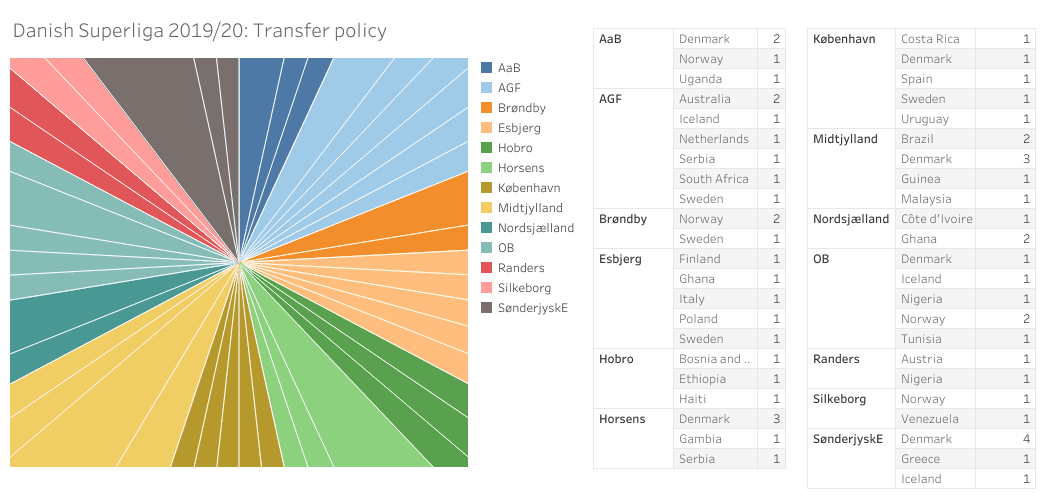
Minutes that count
Usually for new signings, the first year is not a make or break scenario. However, if one can adapt in the beginning to the characteristics of the league then he can easily cement his place in the starting eleven. To measure this effectively, we first took the collective minutes in each team. To see even more details, we factored in the players’ age as well. The size of the dots represents their respective playing time. It is interesting to notice how currently third Aarhus GF utilise their new youngsters or the instant effect taken on FC Copenhagen. Overall, the average age of these transfers (24.5) was slightly below the current league average (25.1) which could be seen as a conscious transfer plan, additional to the local youth development.
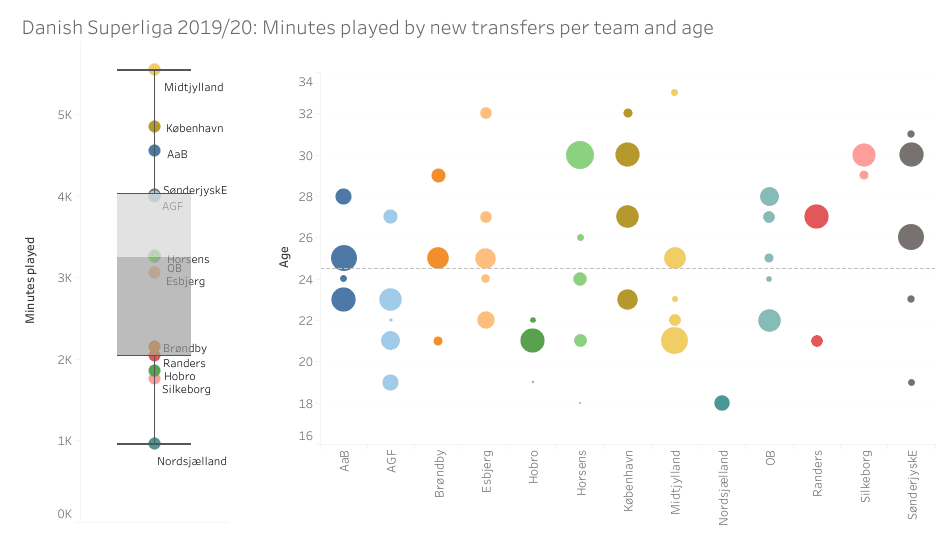
Leaving a mark in defence
So far, this analysis discussed the data on the level of the teams. Now it is time to move to the individuals and gain information on players who had a standout ‘rookie’ season. For this, we included only those who got over 600 minutes on the pitch and broke down the statistics into the three main phases of the game.
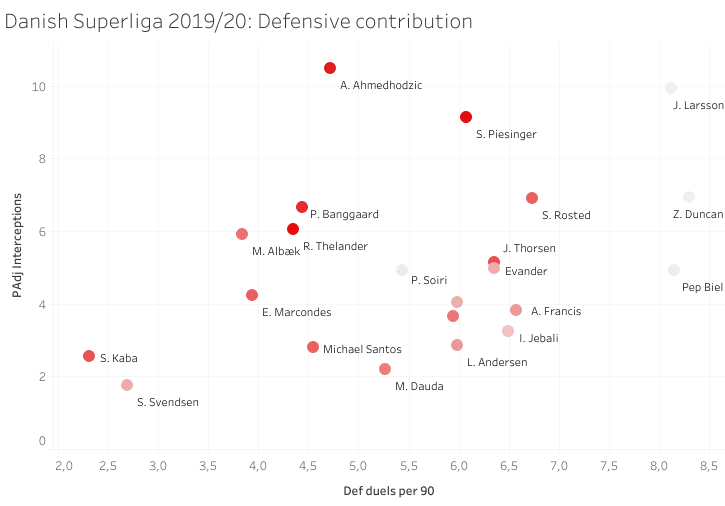
In defence, the Swedish right-back, Johan Larsson delivered a balanced performance at Bröndby. Interestingly, he signed from the Swedish side Elfsborg in 2014 first. After playing four years in Denmark he moved on to the French Guingamp in a free transfer only to return to Bröndby after just half-season. Another half-year went by and he completed the circle by returning to Elfsborg.
Zachary Duncan’s season at AGF was an instant success from the very beginning. AGF’s director of football Peter Christiansen claimed that the 19-year-old Australian central midfielder has a European future ahead of him.
It is easy to get excited about Pep Biel as well. Considering that he plays as a right-winger, his defensive numbers speak for themselves. The 23-year old Spaniard arrived from Real Zaragoza and he instantly contributed to the mild success of FC Copenhagen.
Progression through the midfield
Next, we analyse four passing statistics and talk about the general progression of the ball. These four charts comprise progressive passes, deep completions as well as passes in the final third and to the penalty box. We can see that there are a couple of common names appearing on multiple occasions.
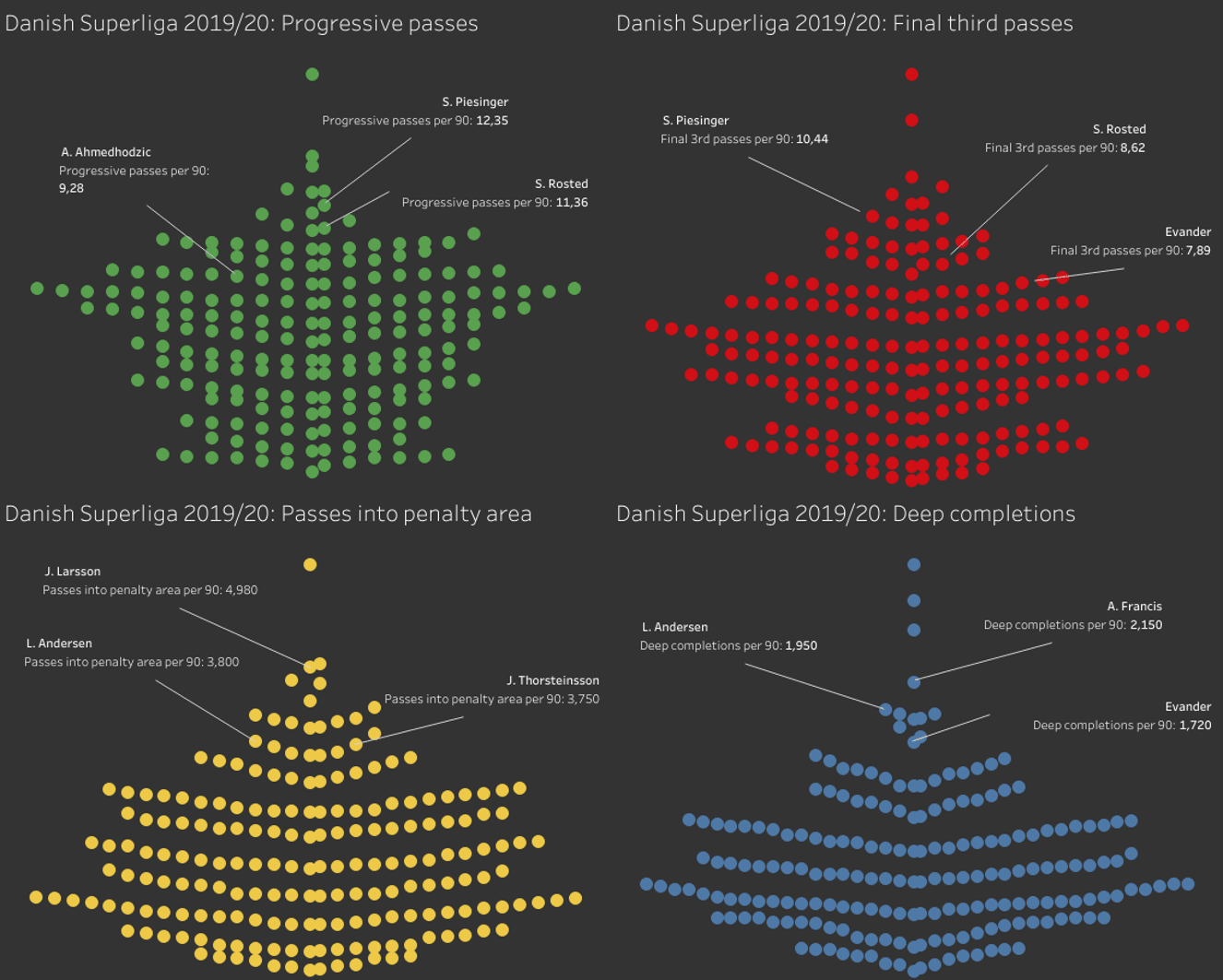
In the first two categories, Simon Piesinger and Sigurd Rosted dominated in the numbers over the rest of the newcomers. Both players are crucial in the build-up, especially Rosted for Bröndby. The Norwegian ball-playing defender averages almost 60 passes per game which could be appreciated in any Premier League teams. Piesinger has always played in Austria before trying his luck with Randers. He could be best described as a direct defensive midfielder, equally contributing to the defence.
Lucas Andersen joined Ajax Amsterdam in 2012. Eventually, he couldn’t get his chance and took him seven years to return permanently to his home club, Aalborg. The reunion could not go any more perfect. With nine goals and eight assists, he took the league by storm and grew into his side’s prime creator.
One player who is tipped to have a prosperous career is a 19-year-old teen from Ghana, Abu Francis. He was discovered by Nordsjaelland which instantly signed him and provided 12 league starts. His creativity can be highlighted by the 2.15 deep completions or the 0.22 expected assists per game.
Goals galore
Strikers are usually evaluated solely by their goals but the underlying statistical data can give us an idea of what to expect from them after their first season in Denmark. Two dimensions that can go hand-in-hand with dangerous attacking movement are shots and touches inside the box. While not every forward has the same playing style, traditionally we can gain valuable information from these metrics.
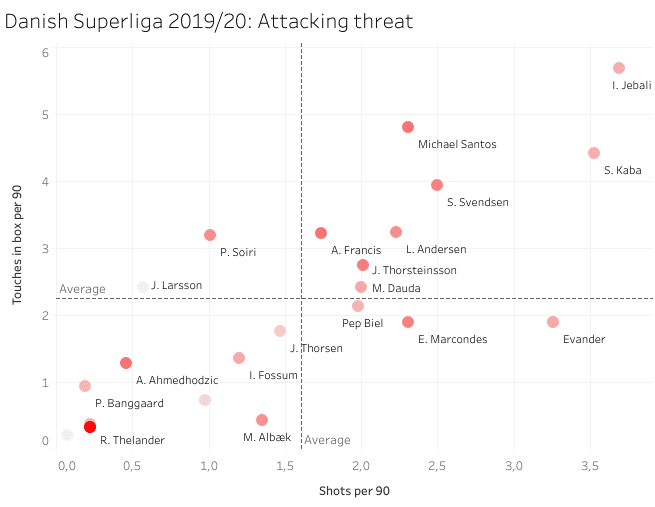
Issam Jebali is an experienced striker with many games in his pocket from both Sweden and Norway. After a short trip to Saudi Arabia, he returned to the north. Despite his chances, his poor goal conversion rate allowed him to score just twice in Odense.
Sory Kaba arrived from Dijon but his transition was smooth with Midtjylland and the club could build on him in the future. He almost reached 0.5 expected goals per 90 minutes while during the season he amassed 7.2 xG.
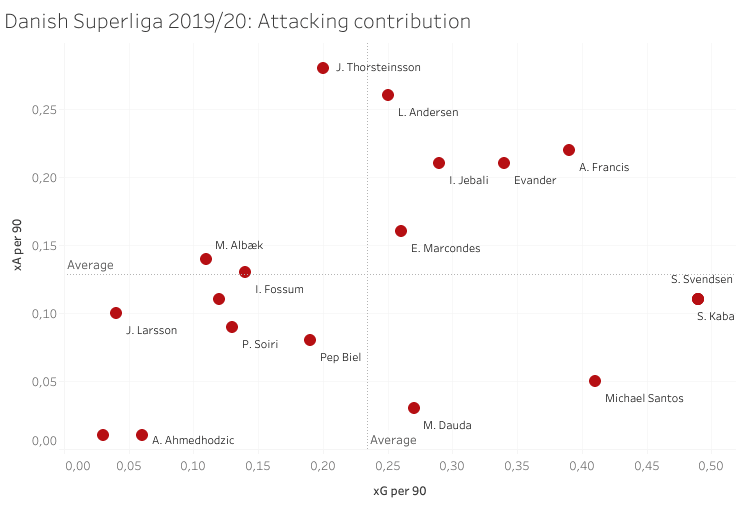
Not only Kaba achieved 0.49 xG per game in 2019. Sander Svendsen signed to Odense as a one-time Norwegian champion and cup winner for only 250,000 euros. OB made a great bargain as he netted nine times and dished out two assists.
On the giving side stands Jón Dagur Thorsteinsson, another young player of AGF. The direct left-winger received applause for his season performance, especially for the 0.28 xA per 90 minutes. He participated in 18% of Aarhus all goals, making him a valuable asset to the team.
Evander the Great
We decided that Evander deserves analysis on his own. He signed from Vasco da Gama to Midtjylland in 2019 after spending the previous year on loan there. While he had a year to adapt pressure was still on his shoulders to perform after the transfer fee paid. He put in an amazing performance, starting this season with a three-goal streak, netting against Rangers in the Europa League Qualifier and he never looked back. His individual numbers deserve recognition among Europe’s bests. He constantly creates chances while has a great shooting technique as well. He can progress the ball deep from the midfield and still be present in defence. It would be surprising to see him in Denmark for much longer.
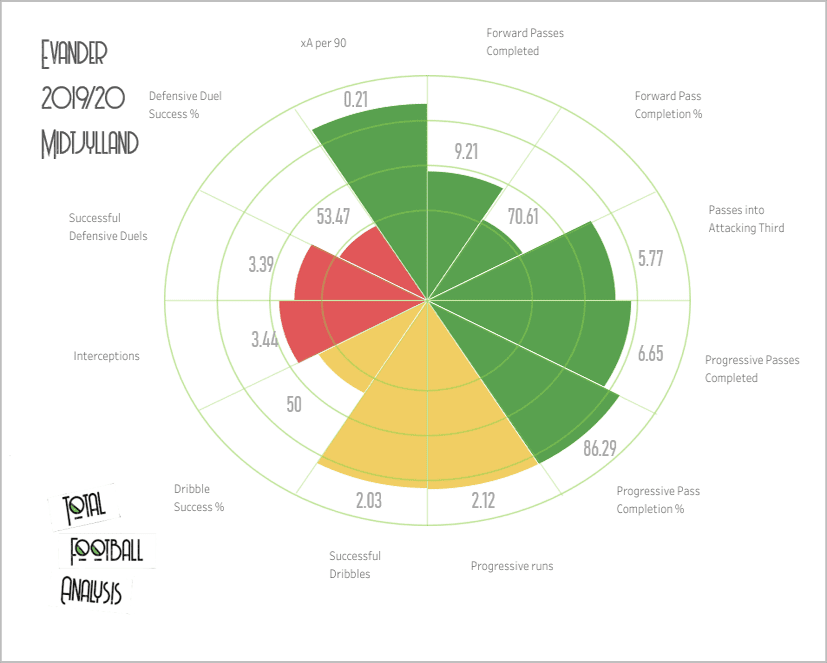
Conclusion
In this data analysis, we focused specifically on the connection of Denmark to the international transfer market. Playing in the Danish Superliga is a superb chance for youngsters to progress in their careers. The clubs have built a world-class scouting network and through that, the turnover of exciting young prospects are continuous and overflowing. On the level of the teams, we examined the playing minutes and the age group from where the players were selected. Using advanced statistics, we identified numerous well-performing players who could have even bigger roles in a new season. Finally, we compared Evander, the number 10 of Midtjylland, to the crème of Europe.
Whether because of the lovely set-pieces variations or the exciting discovery of new talents, the Danish Superliga is worth to be followed and even more worth to write about.
You are going to love what Total Football Analysis are bringing you this weekend.
Starting with the Reiverderby in the German Bundesliga this coming Saturday, May 16 – Total Football Analysis will be bringing you live match commentary and analysis of Borussia Dortmund vs Schalke, kicking off at 14:30 UK.





Comments